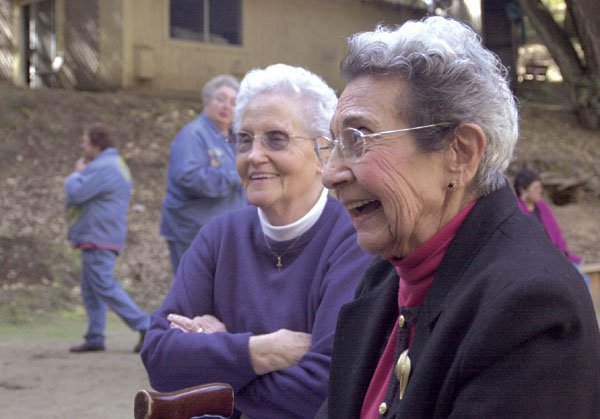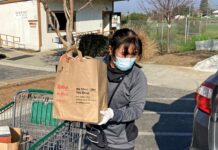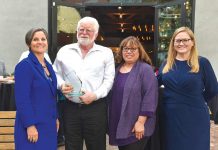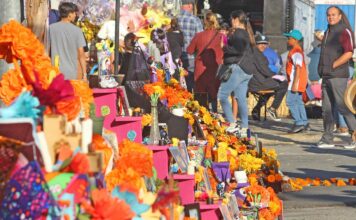Indian Canyon is a sacred place. It’s a holy hidden corner of
San Benito County consecrated by time and tradition.
Secluded in hills just off Cienega Road south of Hollister, it’s
not an easy location to find. But the difficult quest to discover
it adds to its spiritual nature.
Indian Canyon is a sacred place. It’s a holy hidden corner of San Benito County consecrated by time and tradition.
Secluded in hills just off Cienega Road south of Hollister, it’s not an easy location to find. But the difficult quest to discover it adds to its spiritual nature.
Last Sunday morning, I made a pilgrimage to Indian Canyon to observe a special dance ceremony celebrating local Ohlone elders. Driving through an autumn-toned vineyard and into the narrow gorge of the canyon, I was struck by the translucence. Sun poured through the pines, prompting me to recall stained glass in Europe’s finest cathedrals.
From a distance, I noticed a man pounding a beat on a drum. His clear voice chanted a Native American song while dancers practiced moves to the music. I couldn’t understand the words, but they somehow spoke to my soul.
As the performers finished, I met one of the day’s organizers, a jubilant woman wearing a happy smile and a fashionable hat. Ann Marie Sayers, a Mutsun Ohlone, is the tribal chairwoman of the Indian Canyon Nation. She grew up here, and her heart belongs to the place.
“The canyon served as a safe haven for a lot of the people who fled from the Mission San Juan Bautista,” she told me. “It was a hiding place.”
Conditions didn’t improve for the Native Americans when the United States took over California, she said. “An Act for the Governance and Protection of the Indians” signed in 1850 by Governor Peter Burnett essentially put them in a state of slavery.
“Any Indian not under the protection of the whites was picked up as a vagrant,” she said. “Costanoans (the Spanish name for coastal California native people) lost all their culture.”
During this period, many Native Americans were hunted down for a bounty. Five dollars for the head, 50 cents for the scalp, she said.
In 1978, President Carter signed the American Indian Religious Freedom Act, allowing Native Americans for the first time to practice their traditional religions legally, Sayers told me.
Russ Imrie, a Kahnawake Mohawk living in the Santa Cruz Mountains, told me that the day’s traditional dance honoring the elder women would be an important moment for community healing. It was the first time in a very long time such a ceremony had been held in Indian Canyon.
“This is rebuilding a community,” he said. “It’ll probably become an annual thing.”
Women were matriarchs in the original Ohlone society, I learned. They held the spiritual knowledge. They forecast the summer solstice to know when to harvest. They knew what herbs and leaves could be used for medicine. When the Spanish missionaries came with their patriarchal views, they dramatically disrupted Ohlone society, Imrie said.
I soon met one of the elder Ohlone women. Ella Rodriguez is a grandmotherly woman with keen eyes. She is a “monitor,” an archeologist who oversees Bay Area construction digging to make sure Ohlone burial grounds aren’t disturbed.
Social attitudes toward California native culture have changed somewhat in the last 25 years, she said. She recalls in 1975, a Watsonville developer put up buildings on sacred burial ground. “We went out there and asked if we could retrieve the remains and bury them somewhere else,” she said. “He was really angry and told us to get off the property.”
Many people still aren’t aware of the traditional ways of California Indians. But there’s hope for the future, Rodriguez said looking around at youngsters helping to prepare for the ceremony. Unlike previous generations who hid their Ohlone ancestry and claimed to be Mexican, more children take open pride in their ancestry.
“I’m amazed there are a lot of the younger ones who are coming back to their past and learning about their culture,” she said.
Honored elder Babe Littlejohn is a Mutsun Ohlone who grew up in the New Idria region of San Benito County. Her Ohlone father-in-law taught her some of the ancient ways of healing.
“I raised my kids on herbs,” she said. “I’d go up to New Idria and Panoche to collect herbs … Boy, we sure couldn’t afford to go to a doctor.”
Around 1pm, as grey clouds started to canopy the sky, everyone gathered around the bulldozed crater that will one day be the community’s “round house” – the traditional meeting lodge. A tall tree trunk now stands at the center. A small wood fire smoked nearby.
Drum music began, and as the elders watched, nine young women and girls wearing traditional ceremonial attire stepped into the round house pit. Each dropped a small offering of tobacco into the flames, then began the dance.
“Today is a dream come true to me,” Sayers announced from the center. “To see Ohlone elders. To welcome Ohlone elders. It’s long over due.”
The gifts, made by the dancers over the space of a year were given to the women as they were called by name – gifts of pine needle baskets and shell bead necklaces.
“In our native culture, the older you are, the more respected you are because of the number of years you have been with our Mother Earth,” Sayers said.
One Mutsun Ohlone woman, Helen Maldonado, brushed away tears as a shell necklace was placed on her.
“Everything comes back to me from my childhood in what I was taught,” she said. “This is a connection to the past.”
Several more dances followed, and after the ceremony, a feast was served. I was hoping to sample traditional Ohlone food – perhaps some acorn mush.
“No. We’re having lasagna,” Weighill told me with a grin. “Maybe we’re Italian Indians.”
As I waited for others, I heard the creek gurgle nearby. The Indians call running water “Rumme,” (rum-mah). It’s “the blood of the Earth.”
A breeze bringing the rain sighed along the tops of autumn sycamores. For a moment, I imagined the presence of the ancestors. I sensed they might be watching.












